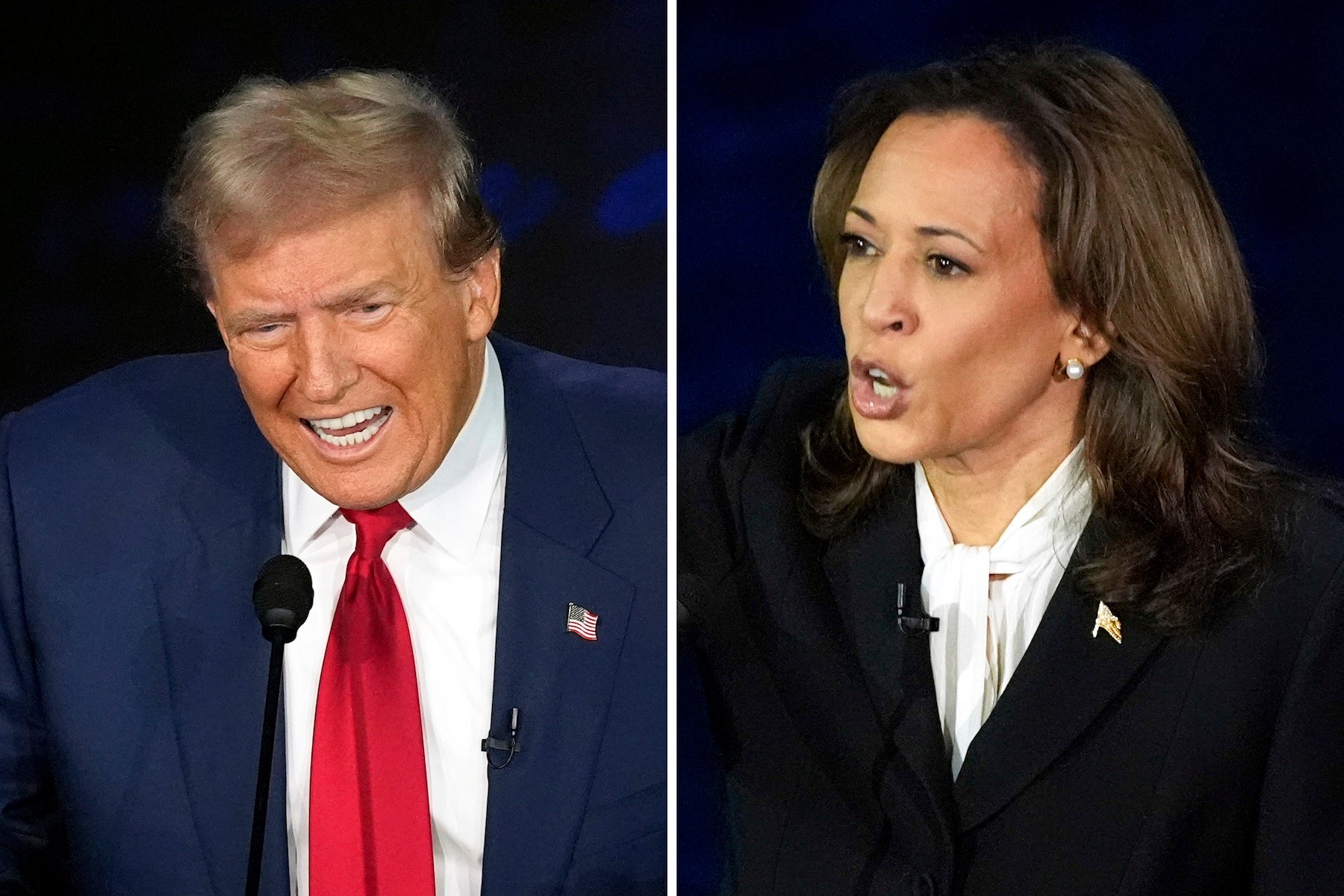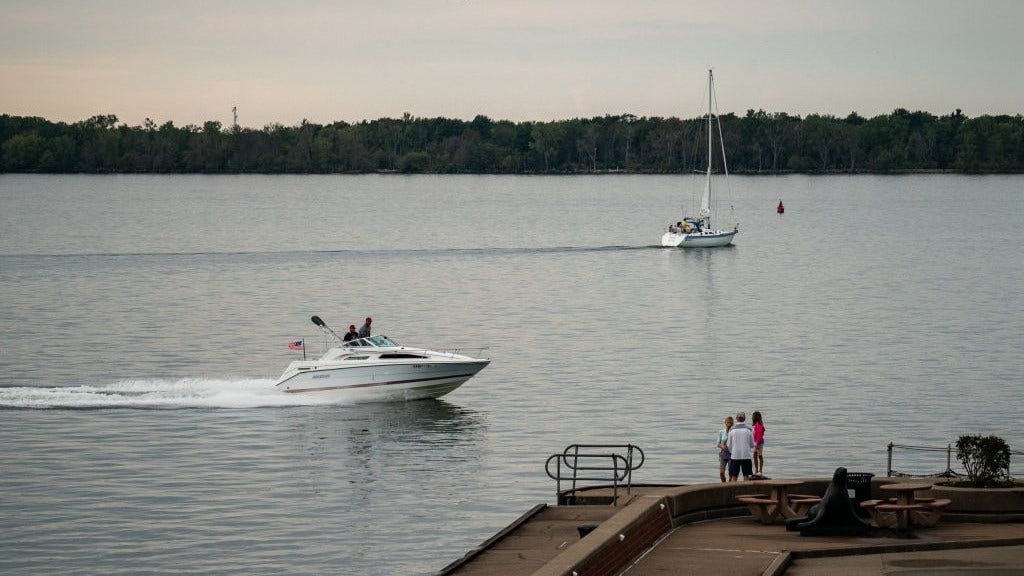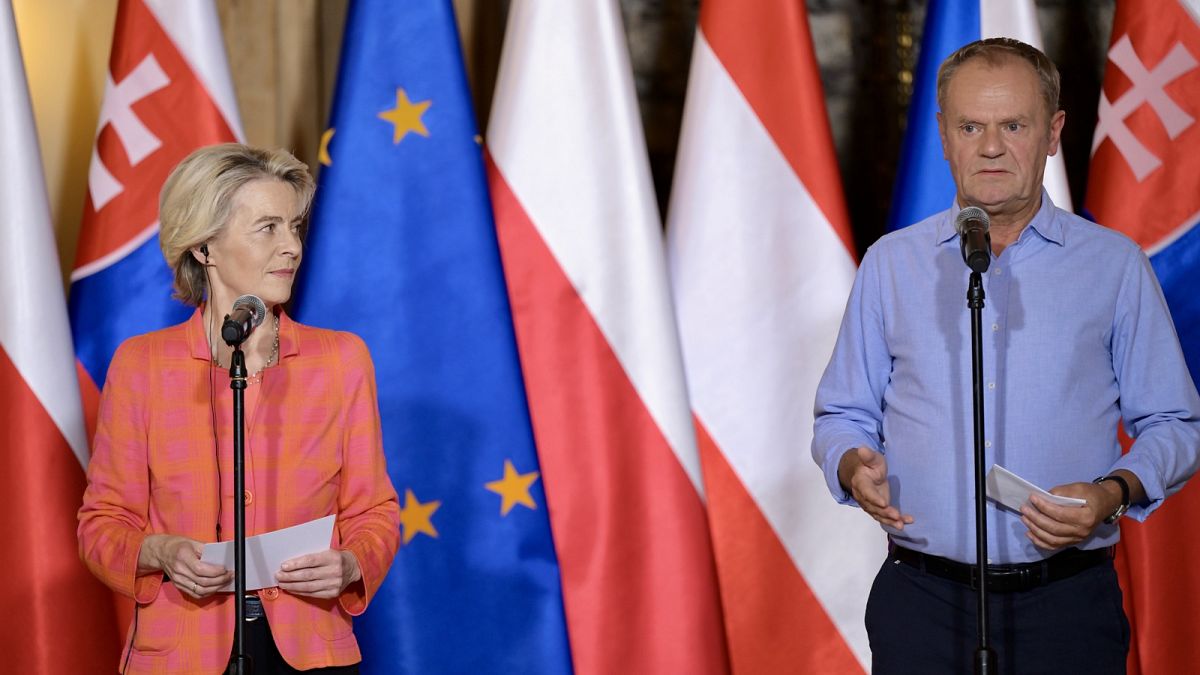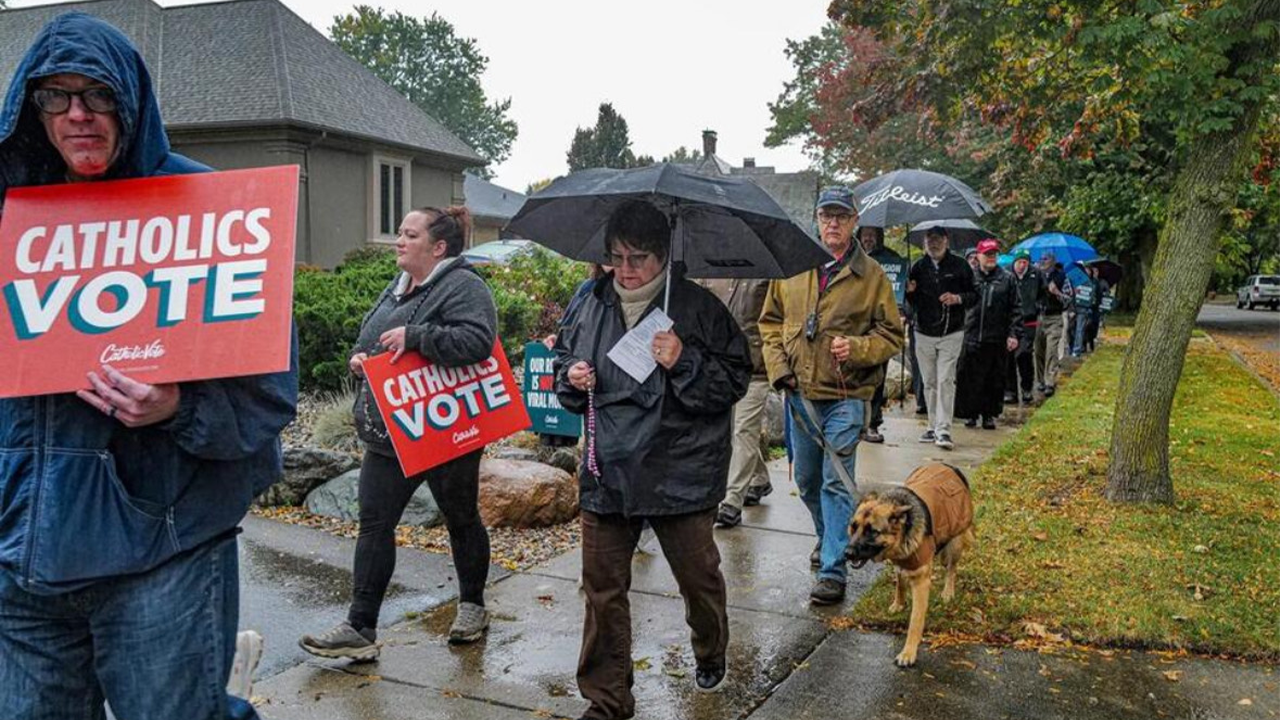Sports
Chargers' Jim Harbaugh explains heart issue that led to his brief exit from game vs Broncos
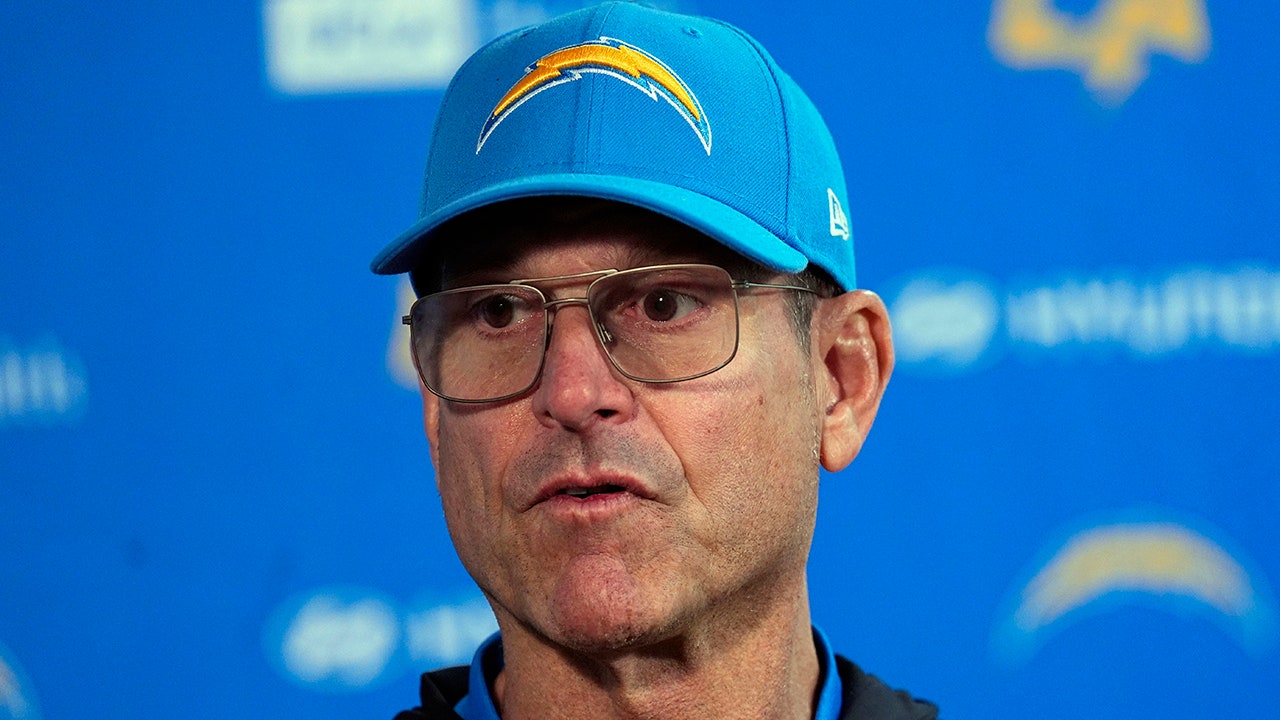
Los Angeles Chargers head coach Jim Harbaugh raised concerns early in Sunday’s game against the Denver Broncos when he left the sideline and headed to the locker room.
The concerns led to Baltimore Ravens head coach John Harbaugh abruptly ending his postgame press conference to call his brother to make sure everything was OK.
Los Angeles Chargers head coach Jim Harbaugh responds to a question during a news conference after defeating the Denver Broncos in an NFL football game on Sunday, Oct. 13, 2024 in Denver. (AP Photo/David Zalubowski)
In the end, everything was OK.
Jim Harbaugh returned to the sideline and coached the Chargers to a 23-16 win over the Broncos. He explained he got checked for an irregular heartbeat.
“Everything ended up turning out to be OK,” he said. “The doctors checked me out, and it got back into normal rhythm. So came back. … It’s the heart so you take it seriously.”
Harbaugh, 60, said he dealt with atrial flutter. He had an ablation procedure in 1999 to treat irregular heart rhythms. He had another one in 2012 when he was the head coach of the San Francisco 49ers.
The condition causes the heart to beat too quickly.
RAIDERS’ MAXX CROSBY SHOVES ASSISTANT COACH AS TEAM LOSES TO STEELERS: ‘LOVE PUSH’

Los Angeles Chargers head coach Jim Harbaugh, left, stands in a tunnel with players before an NFL football game against the Denver Broncos on Sunday, Oct. 13, 2024 in Denver. (AP Photo/David Zalubowski)
“I started feeling it last night, but wasn’t really sure,” Harbaugh said. “Just like in 2012, it was during the pregame warmups — I kind of started feeling.”
He added, jokingly, “2-0 in arrhythmias.”
Harbaugh left the game as the Chargers drove down the field and started their win off with a field goal.
Justin Herbert said Harbaugh mentioned something about his health on Saturday night.
“He said he was really excited for the game. He said his blood was flowing, and he was excited,” Herbert said. “I thought everything was good to go. That’s definitely something he should get checked out. He’s a tough guy, though.”
Harbaugh first went to the blue medical tent. He was seen going to the locker room where the medical staff took his pulse and conducted an EKG.
“Trust the doctors. If you’re not going to trust your doctors, who are you gonna trust?” he said. “Came back in to the locker room, and the paramedics came, got an EKG and said it was back to the sinus (normal) rhythm, and I said, ‘I feel good.’ I went back out there on the field.”

Los Angeles Chargers head coach Jim Harbaugh looks on before the game against the Denver Broncos at Empower Field at Mile High in Denver on Oct. 13, 2024. (Ron Chenoy-Imagn Images)
Harbaugh said he will see a cardiologist on Monday.
The Associated Press contributed to this report.
Follow Fox News Digital’s sports coverage on X, and subscribe to the Fox News Sports Huddle newsletter.

Sports
Pablo Cuevas’ best shots, from tweeners to no-look forehands — in his words

Two weeks ago, Uruguayan tennis player Pablo Cuevas announced his retirement.
When it came, tennis fans the world over dipped into their memory banks in admiration of the modern master of the trick shot. With excellent hands and a huge amount of talent, Cuevas could pull off shots from between his legs, no-look winners, drop-shot returns and so much more at will.
But like Mansour Bahrami, the trick-shot king to whom he was heir, Cuevas was far more than just a flashy shotmaker. On his day, he could compete with the very best players in tennis. In 2016, he defeated Rafael Nadal on clay in Rio de Janeiro en route to winning one of his six ATP titles (all of which came on the surface), achieving a singles career-high ranking of world No. 19 later that year. He also won the 2008 French Open doubles title with Peru’s Luis Horna, beating the legendary Bob and Mike Bryan along the way.
Speaking from his home on the outskirts of Montevideo, Cuevas looks back on some of his most spectacular shots and insists that, with one exception, they weren’t something he practised.
“It was all spontaneous,” he says.
On the day we speak, Cuevas looks refreshed from a morning spent surfing in the South Atlantic Ocean. He is enjoying being able to do water sports regularly, when he isn’t hanging out with his wife and two daughters or coaching promising under-18 Uruguayan tennis players. Occasionally he plays tennis or padel with his compatriot Diego Forlan, the former Manchester United striker who, this summer, told The Athletic about his switch from football to the ITF veterans’ tour.
Before we get into the clips, I want to know how he developed his ability to hit extraordinary shots:
As a young player, did you always hit fun trick shots? How did that develop?
I didn’t practise that at all. Just as there was one every 50 games in a match, also in training, every 20 games there was one. It wasn’t like a training session for those kind of shots. They just came out like that. And in matches, more spontaneous plays would come out in different situations.
So when you were practising you would just hit them as they came?
The fake smash and hitting it under the legs, I did practise it once. The first and only person I saw do it was (former French Open champion Gaston) Gaudio in a training session we shared. Other than that, that tweener point with Nadal and so on, I never practised it.
Yep, we’ll get to that one. These shots are probably what you’re most remembered for — is that a nice feeling for you, to know that your memory will live on in that way? Does it bother you that that’s what you’re best known for?
It’s something I definitely realised people like a lot, something that’s very present in their minds. But you feel more pride at something you achieve with hard work, that you practise and little by little you incorporate into your game until you achieve it. And that’s not the case here. So it’s not something that I worked at and I’m super proud of, but it doesn’t annoy me that I’m remembered for that or that people enjoyed it.
The first point we watch features both a tweener (tennis speak for a shot between the legs), and then a lob over Gael Monfils, himself a spectacular shotmaker. It comes from a tight match at the Madrid Open eight years ago, which Cuevas won 6-7(5), 6-3, 7-6(4).
This first shot is one from between between your legs. Was that a favourite shot of yours?
It’s definitely one of the nicest shots to see. It’s a nice play.

Some types of players, the ones that are very monotonous in their game, kind of bore me.
You have a few choices. You go for the lob. Why did you hit that there? Did you see how close Gael was to the net?
I don’t think I was a great lobber or a shot I used a lot. Gael is a very agile guy and saw that he was very close to the net and thought the best place to put the ball was there.

Was it fun playing against someone like Monfils, who also hit trick shots?
Yes, he was a very flashy player, the kind I like to watch. One of those that I also liked to play against. He could surprise you at any moment with his serve, with his shots or with his great reach that he uses to defend or hit spectacular shots.
As the best player hitting spectacular shots, is your successor Alexander Bublik? Or Nick Kyrgios? Who do you think is the man now?
What Kyrgios does is more spectacular, but with his ball speed, with his wrist acceleration or even sometimes more with his attitude than shots like that. Bublik tries to do more of this kind of thing and you also have Monfils, who is the most similar in that sense, because it’s not that he’s constantly looking for it, but every now and then he comes up with something similar.
If there’s one player out there who’s looking for more of that it could be Bublik. He’s looking for that magic all the time, that kind of shot.
Are these the kinds of players you most like to watch?
I like to see players like Kyrgios. Not necessarily when he’s a little bit out of his mind, but when he has those moments of magic. He’s a player I like to watch. I like to watch Monfils, but I also enjoy some more classic players. (Stan) Wawrinka doesn’t do that kind of thing, but I really like to watch him.
With possibly the most outrageous shot of the bunch, Cuevas hits a forehand winner against Nadal at the Paris Masters seven years ago, in a manner barely seen before or since.
You mentioned this shot earlier, and you were saying this was just pure improvisation.
Yeah, totally. In 10 years of practice, I maybe produced that shot once.

How did it feel when it came off?
Well, you can see a little bit on my face, and there’s a guy in the crowd with an expression like, ‘Wow!’. It’s also having that unconsciousness. Not thinking about the shot makes it flow that way, because when you miss those shots, it’s horrible. When it works somewhere like that, like a centre court in Paris-Bercy or Madrid, it’s spectacular.

Did Rafa say anything about it?
No. He looked at me with a surprised look on his face, as if to say, ‘What a great shot, but I’m not too amused by you doing this to me!’.
But we have a great relationship and he was far from offended by that. He was one of the players I was closest to on the tour.
How was it playing Rafa compared to Roger Federer or Novak Djokovic?
All three were super different. Roger was the most aggressive, the one who served the best but at the same time gave you the most free points. It was almost difficult to suddenly lose 6-2, 6-2, 6-2. With Roger, maybe I would lose 6-4, 6-4 or, in fact, the two times I played him it was even closer than that (7-6, 6-4 and 6-3, 7-6). Even with those results, you were far from beating him because it was so dependent on him. The game was very aggressive and you always felt very uncomfortable.
With Rafa, when he wasn’t aggressive, he let you play. You felt like you could get into the match all the time, he even made you feel that the match depended a little bit on you.
And with Djokovic, it was a mix between those things. He didn’t have the aggressiveness, especially with his serve, of Roger. And he didn’t slow down the game as much as Rafa. He was somewhere in between.
This year, Ons Jabeur, another gifted shotmaker, told The Athletic: “I love messing around with some players. It’s a lot of fun.”
Cuevas possessed a similar ability to drive his opponents to distraction. In the first example, against John Isner in Madrid in 2018, the American collapses in disbelief at Cuevas’ brilliance. In the second example, Alejandro Davidovich Fokina is so wound up by his opponent’s retrieval skills that he smashes a ball out of the stadium on the way to losing the semifinal in Estoril five years ago.
With this Isner shot, what’s really funny about this is the reaction that John gives when you squeeze the ball past him…
There’s a mixture of feelings. He’s saying, ‘I can’t believe where you’re hitting this ball from and where you’re putting it’. And in a way, he’s thinking, ‘That’s the only one I have to cover. I have to cover the down-the-line. If there’s one place he can’t get past me, it’s there’.

Did you find it funny when players would react like that after your shots?
There’s not so much time to see all that on the court, compared to when you see it thousands of times in a replay. But you sense it, and at the same time it’s a confidence boost — both the reaction of the opponent and your own good shot.

Somehow the ball lands in — to Isner’s disbelief (Tennis TV)
This is another reaction that’s a bit similar, against Davidovich Fokina. He can’t believe the shot you hit.
Yeah, that was much more of a fluke than the Isner one. And yes, he looks frustrated. I don’t remember what the score was, but I think if I was ahead it was to finish him off and if things were even it was to start to take advantage in that match.
It was a big turning point — Cuevas broke his opponent’s serve and then won nine of the final 12 games.
Undoubtedly, there were emotional things that had an influence. It took the opponent down and lifted me up.

Is this one pure instinct again?
Absolutely, to practise that I would need a person to throw me that ball because that ball was coming very fast. That was a last-resort thing. My body is going one way and the ball is staying behind me. There was nothing to come up with. I don’t know how that came out.

The next shot is something associated with Federer — a drop-shot return. It comes against the diminutive Argentinian, Diego Schwartzman, from a match in Hamburg in 2015 that Cuevas won in straight sets. This one was more premeditated.
Given this was a return rather than a shot in the middle of a rally, was it a bit more tactical? Or a shot you had talked about with your coach?
Yeah, this is less improvised. I didn’t suddenly discuss a drop shot with my coach, but Schwartzman was a solid guy from the baseline. You had to change his speed, his rhythm, and also take him out of his comfort zone.


There’s so much sidespin on the ball that by the time it bounces for a second time it’s almost outside the tramlines (Tennis TV)
Did your coaches ever say to you, ‘You need to hit fewer crazy shots’, or was it something you discussed? Or did they know that was just how you played and so they embraced it?
No, that didn’t happen. Because in my 15, 20 years of tennis, there are 15, 20 shots like that. If you take that average, it was one per year. Luckily a lot of those shots came off, so there was no reproach.
This one is the showboating shot against Stefanos Tsitsipas in Estoril that Cuevas said earlier was a shot he had practised. It’s an outrageous no-look, behind-the-legs volley.
This is showboating, isn’t it? This is having some fun?
Maybe it’s the most controversial shot, in the sense that, for the others, there were no better options. In this case, there were many. This was the worst option, to do that. And even when this goes well, the person on the other side may not like it. A lot more people liked it than didn’t like it, but there are also some who didn’t like it and I can understand that.
It’s one where you miss a shot like this, you look bad and are left asking yourself, ‘What did I do?’.
But I made it and it raised my level.



Did Stef mind, do you think?
He didn’t like it on the court. There wasn’t even eye contact to say, ‘Hey, that was a good one’ or, ‘I can’t believe what you did’. It was like, ‘I’m not looking at you because I didn’t like it’. But those are things that happen in matches. I have a really good relationship with Stefanos.
Arguably the best shot of Cuevas’ career, against Zverev from a quarter-final he won in 2017, is so memorable that the Madrid Open tasked Bublik with trying to recreate it this year. He eventually just about got there.
But it’s still not a patch on the original:
“Are you kidding me?! This guy is absolutely mainline,” as commentator Rob Koenig put it. There’s also a drop shot and the chasing down of an Alexander Zverev drop shot leading up to the flicked no-look winner that Cuevas hits.
Possibly your most famous shot — talk us through it.
Well this one, I really had no other option. I was really far back and I had to run fast to get to that ball. I ran the whole court from that drop shot back there. That might be the best one. Maybe the toughest one to pull off is the one we just saw with Tsitsipas. But this one I’ve taken the best option in the best way.



You must have been pretty quick. How much was it natural, and how much did you work on your athleticism?
I worked a lot, in the physical part and in the hours spent playing tennis. I dedicated a lot of time to training in general and without a doubt to the physical part.
The last couple of shots we see show some more of the variety in Cuevas’s game.
First, he puts a ridiculous amount of spin under the ball to take it away from Matteo Berrettini in the quarter-final of the 2019 Hungarian Open.

Cuevas says: “I don’t think I made up anything. Undoubtedly, after so many years of tennis, you see a lot of things, you practise, you put your stamp on it. It’s a mixture, a bit of everything.”
The next one is a diving backhand against home favourite Fernando Gonzalez in the 2008 Chile Open semifinal, which won Cuevas a spectacular point but at the cost of an injured back.
Was that something you were comfortable doing, diving around the court?
I basically never did it. In 20 years, I did it twice: that time and in a Davis Cup tie. That point was good. It was at the end of the second set, almost to get me to match point. But that fall gave me back pain for something like six months.
So did you regret doing it?
A little bit, yeah. I remember thinking many times, ‘How important is it to win a point or not?’, and being careful before doing something like that. But those things happen so fast that there’s not much time to think before doing it.
As we finish up, I wonder if there are any other shots that Cuevas remembers particularly fondly.
He chooses an underarm serve, that he hit having missed his first serve when up championship point in the 2017 Brazil Open final in Sao Paolo, against Albert Ramos-Vinolas. He ended up winning the point and cites it as an example of a shot that might look like the choice of a maverick but is, in reality, simply the most expedient way to win at that moment.
“A lot of people said, ‘Wow, what talent’, or, ‘Wow, how did he dare do something like that?!’,” Cuevas says of this point.
“The reality was a lot less talented or glamorous than what people see.
“I’d committed 12 double faults in that match, I wasn’t controlling my serve. When I missed the first serve, in those five seconds between one serve and the other you start to think: ‘Oh, I can’t commit another double fault… if I don’t win it here, I’ll never win it again… don’t miss the serve… serve underarm… but if you serve underarm, what are they going to say after the match?’.
“All that in five seconds,” he says.
“So I said to myself, ‘Serve, get it in and finish this. Then we’ll see’.
“But if you look at it, there’s nothing talented about it. It’s stiff, tense. The only thing I didn’t want to do was miss the serve.”
Looking back on his career, Cuevas mentions the “spectacular achievement” of winning the Roland Garros doubles in 2008, and cites his 6-7(6), 7-6(3), 6-4 win over Nadal in Rio de Janeiro eight years later — because, unlike the trick shots, it was the consequence of years of hard graft.
“In singles, you put in a lot of hard work. In that long match with Nadal on clay, where you have to spend three hours playing, it’s very tough,” he says.
“To win, you have to finish playing better than the other player. It’s not like football, where you do things well for a while and if the other team doesn’t score goals, the match is over.
“Here you have to keep up that level and that’s what I managed to do in that match.” Cuevas backed up that win by beating Guido Pella in the final, to win his only ATP 500 title.
In retirement, he is enjoying spending time with his family, hitting the beach and coaching junior players; he wants to get involved in real estate development and develop an investment portfolio.
And the tennis world might yet see him in Bahrami-style exhibition matches.
“I like that idea,” he says, smiling at the possibility of getting to experiment with some new shots.
— Tomas Hill Lopez-Menchero contributed translation.
(Top photos: Adam Pretty, Elsa / Getty Images; Design: Eamonn Dalton for The Athletic)
Sports
Matthew Stafford asked if Week 6 off is a help to Rams: 'I don’t know. We’ll see.'

During his first 15 NFL seasons, Matthew Stafford’s teams experienced scheduled off weeks at various junctures.
Three times they arrived as early as Week 5; once as late as Week 10.
With the Rams 1-4 after an Oct. 6 defeat to the Green Bay Packers, their star quarterback was asked if their Week 6 time off was coming at a good time.
“I don’t know,” Stafford said. “We’ll see.”
That’s a perfect mantra to accompany the Rams through their remaining 12 games.
On Sunday, when they play the Las Vegas Raiders at SoFi Stadium, we’ll see if coach Sean McVay devised a workable plan to once again turn around a team on the brink of falling out of the playoff race.
We’ll see if receivers Cooper Kupp and Puka Nacua and offensive linemen Steve Avila and Joe Noteboom are ready to return from injuries that left the Rams shorthanded against the Detroit Lions, Arizona Cardinals, San Francisco 49ers, Chicago Bears and the Packers.
We’ll see if defensive coordinator Chris Shula made scheme and personnel adjustments that will elevate the Rams from their statistical position at or near the bottom of the league.
One thing is certain: The Rams cannot expect Stafford to produce miracle comebacks every week.
Sure, he did it for the 36th time in victory over the 49ers at SoFi Stadium.
McVay, Rams and fans no doubt anticipated a repeat when Stafford engineered a fourth-quarter touchdown drive against the Packers that pulled the Rams within five points. Stafford got the ball back with less than three minutes left and had the Rams on the move but his fourth-down pass in Packers territory fell incomplete.
Stafford, 36, has persevered despite a still-patchwork offensive line and the injury-related absence of star talent at receiver.
During the offseason, the Rams invested a combined $66 million in interior linemen Kevin Dotson and Jonah Jackson. They tendered left tackle Alaric Jackson for nearly $5 million.
Stafford, however, has yet to take a game snap behind the projected starting offensive line.
Alaric Jackson was suspended for two games for violating the league’s personal-conduct policy. Avila and the versatile Noteboom went down in the season opener, and Jonah Jackson suffered a similar fate in Week 2.
Rams quarterback Matthew Stafford hugs Kyren Williams after the running back’s touchdown run against the Packers.
(Wally Skalij / Los Angeles Times)
Stafford played the last four games behind a line that featured rookie center Beaux Limmer, and the last three with left guard Logan Bruss, a 2022 draft pick, playing for the first time.
The Packers hit Stafford 10 times and sacked him three times, leaving him with a sore back.
Despite the line shuffle, running back Kyren Williams is scoring touchdowns. And after failing in their first opportunity against the Packers, the Rams showed improved touchdown production from inside the 20-yard line.
Receivers Demarcus Robinson, Tutu Atwell, rookie Jordan Whittington and tight end Colby Parkinson all have had their moments but they are complementary players in a receiving corps that requires Kupp and Nacua.
The young defensive front has made an impact in the early post-Aaron Donald era, but trading inside linebacker Ernest Jones IV, and thinking that Troy Reeder and Christian Rozeboom could fill the void, remains questionable.
The secondary is shaky, though Shula had to be encouraged by Jaylen McCollough’s interception return for a touchdown against the Packers.
McVay sat former cornerback Tre’Davious White against the Packers. Although the former All-Pro has struggled, expecting a player coming off Achilles surgery to be his former self at the start of the season was probably asking too much.
Cornerback Darious Williams played for the first time this season against the Packers, and safety John Johnson III is eligible to return from injured reserve after the game against the Raiders.
Special teams have mostly played well. Rookie kicker Joshua Karty was perfect until he missed a field-goal attempt against the Bears and an extra-point attempt against the Packers.
Last season, the Rams lost to the Packers in Week 9 and fell to 3-6 before they returned from an off week. Stafford then earned Pro Bowl recognition by leading the Rams to the playoffs.
Of the Rams’ remaining opponents, only the Minnesota Vikings, Buffalo Bills and Philadelphia Eagles have winning records through action Sunday.
Can McVay and Stafford lead the Rams on another run to the playoffs?
We’ll see.
Sports
AP Top 25: Texas keeps No. 1 ranking ahead of Georgia visit; Oregon moves up to No. 2

Oregon moved up to No. 2 behind top-ranked Texas in the AP Top 25 college football poll Sunday after their dramatic win against Ohio State.
The Ducks jumped a spot after beating Ohio State 32-31 in a thriller at Autzen Stadium on Saturday night for their highest ranking since finishing the 2014 season at No. 2. The fourth-ranked Buckeyes’ first loss of the season cost them only two spots, as they also fell behind Penn State, which moved up to No. 3 after beating USC in overtime.
Texas received 56 first-place votes after blowing out Oklahoma, while Oregon had six. The Longhorns’ hold on No. 1 will be on the line next Saturday night when No. 5 Georgia visits Austin in another top-five matchup in the SEC. It’s the third AP top-five matchup in four weeks.
The biggest mover is LSU, which jumped five spots to No. 8 after beating Ole Miss, which plummeted nine spots to No. 18. The Tigers have won five games in a row since their opening loss to USC. Undefeated Iowa State also cracked the top 10 at No. 9 after a win at West Virginia.
Tennessee dropped three spots despite winning, slipping to No. 11 after needing overtime to beat Florida.
AP Top 25 after Week 7
|
Rank
|
Team
|
Record
|
Prev.
|
Matt’s vote
|
|---|---|---|---|---|
|
1 |
6-0 |
1 |
2 |
|
|
2 |
6-0 |
3 |
1 |
|
|
3 |
6-0 |
4 |
4 |
|
|
4 |
5-1 |
2 |
3 |
|
|
5 |
5-1 |
5 |
7 |
|
|
6 |
6-0 |
6 |
5 |
|
|
7 |
5-1 |
7 |
6 |
|
|
8 |
5-1 |
13 |
15 |
|
|
9 |
6-0 |
11 |
9 |
|
|
10 |
5-1 |
10 |
8 |
|
|
11 |
5-1 |
8 |
16 |
|
|
12 |
5-1 |
11 |
13 |
|
|
13 |
6-0 |
14 |
10 |
|
|
14 |
5-1 |
15 |
14 |
|
|
15 |
5-1 |
17 |
11 |
|
|
16 |
6-0 |
18 |
12 |
|
|
17 |
5-1 |
18 |
17 |
|
|
18 |
5-2 |
9 |
24 |
|
|
19 |
5-1 |
21 |
22 |
|
|
20 |
6-0 |
22 |
18 |
|
|
21 |
5-1 |
25 |
19 |
|
|
22 |
5-1 |
23 |
25 |
|
|
23 |
6-0 |
NR |
21 |
|
|
24 |
4-2 |
24 |
NR |
|
|
25 |
5-0 |
NR |
20 |
|
|
NR |
4-2 |
NR |
23 |
Others receiving votes: Vanderbilt 68, Nebraska 62, Arizona State 39, Oklahoma 36, Washington State 32, Iowa 29, Texas Tech 18, Syracuse 13, Arkansas 13, Utah 7, Louisville 6, Southern Cal 5, Liberty 2, UNLV 1
In and out
Oklahoma fell out of the rankings for the first time since 2022 after the Sooners were routed by Texas in the Red River Rivalry. Utah is also out of the rankings for the first time this season after the Utes lost their second consecutive game on Friday night to Arizona State.
In their spots are undefeated Army (No. 23) and Navy (No. 25). It’s the first poll the Black Knights and Midshipmen have appeared in together since 1960. Vanderbilt just missed after its wins against Alabama and Kentucky, as it’s the first team out.
Why I voted Oregon No. 1
Most of my adjustments this week were relatively subtle, with moves of one or two places for much of the top 20. I did, however, decide to vote for another new No. 1: Welcome to the top of my ballot, Oregon.
Yes, it feels odd to move a team like Texas down after the Longhorns beat their rival by 31 points, but the decision was much more about giving Oregon the respect it deserves for notching what could be the best win of the season so far against Ohio State, which I dropped only one spot to No. 3. Plus, the Ducks also have a win against a Boise State team I have ranked 11th behind Heisman Trophy candidate Ashton Jeanty. The Ducks have the best combination of talent and resume.
Of course, if Texas beats Georgia next week, I’ll likely make another swap at the top of my rankings. — Matt Brown, college sports managing editor
Does Penn State deserve to be No. 3?
The Nittany Lions have their best ranking since reaching No. 2 in 2017, but it feels like they are more the beneficiary of the results of other big games than truly worthy of that lofty ranking.
Penn State is only 23 points ahead of No. 4 Ohio State, so it’s not as if voters went flocking to the Nittany Lions.
To be clear, Penn State has done good work against respectable opposition. Especially when you take into consideration road games at West Virginia and USC and a thorough handling of Illinois.
Voters are rewarding the unbeaten record, but it feels like a stretch to make the case that the Nittany Lions are actually better than Ohio State and Georgia, with their narrow and dramatic losses to Oregon and Alabama, respectively.
And if voters are deferring to the zero in the loss column, a similar case can be made for Miami ahead of the Buckeyes and Bulldogs.
Of course, Penn State will get its chance to prove it on the field in a few weeks at home against the Buckeyes, who they have not beaten since 2016. — Ralph Russo, college sports senior writer
What’s next in Week 8?
No. 5 Georgia visiting No. 1 Texas is the headliner, and it’s the first time the Longhorns have hosted a matchup of two AP top-five teams since a loss to Ohio State in September 2006. The SEC has a pair of high-profile matchups, as No. 7 Alabama will visit No. 11 Tennessee in a game between two one-loss teams that have been on shaky ground the past couple of weeks.
The other ranked matchup is No. 24 Michigan at No. 22 Illinois, though also keep an eye on Nebraska going to undefeated No. 16 Indiana in the Big Ten.
Oregon, meanwhile, will try to avoid a hangover on Friday night at Purdue. Penn State and Ohio State are both idle.
Required reading
(Photo: Sam Hodde / Getty Images)
-

 Health1 week ago
Health1 week agoHealth, happiness and helping others are vital parts of free and responsible society, Founding Fathers taught
-

 Sports1 week ago
Sports1 week agoFreddie Freeman says his ankle sprain is worst injury he's ever tried to play through
-

 News1 week ago
News1 week agoLebanon says 50 medics killed in past three days as Israel extends its bombardment
-
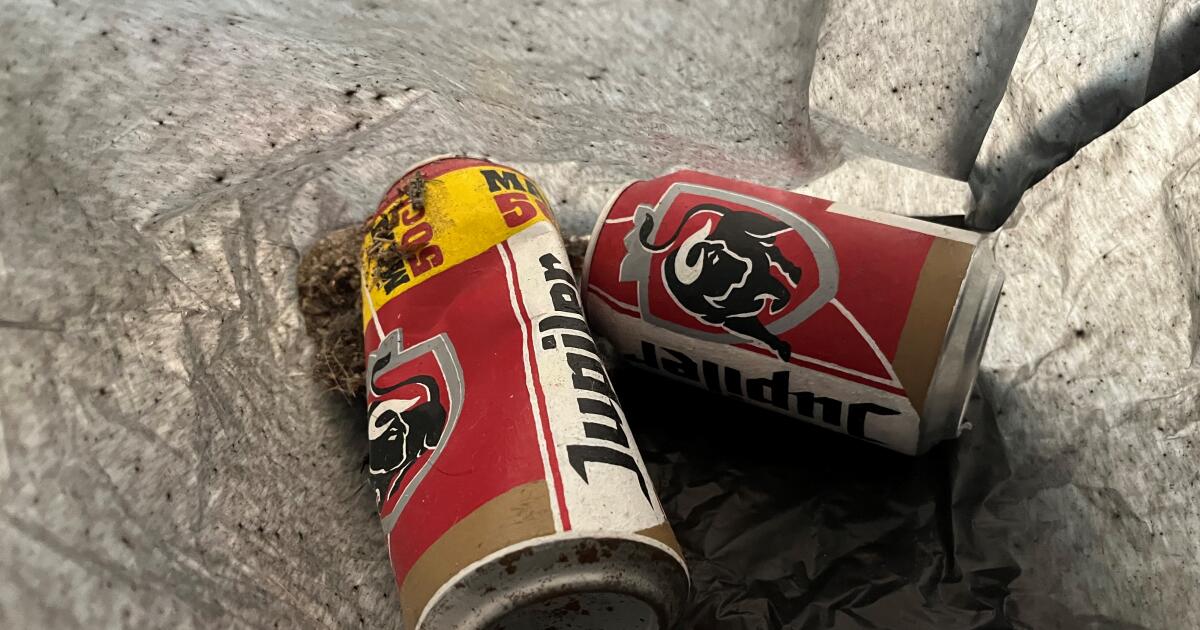
 Entertainment5 days ago
Entertainment5 days agoHold my beer can: Museum says a worker thought unique art installation was trash
-

 Entertainment6 days ago
Entertainment6 days ago'The Office' star Jenna Fischer reveals private breast cancer battle: 'I am cancer free'
-
/cdn.vox-cdn.com/uploads/chorus_asset/file/25673932/462754179_560996103109958_6880455562272353471_n.jpg)
/cdn.vox-cdn.com/uploads/chorus_asset/file/25673932/462754179_560996103109958_6880455562272353471_n.jpg) Technology2 days ago
Technology2 days agoMeta suggests AI Northern Lights pics are as good as the real thing
-

 Technology4 days ago
Technology4 days agoScammers exploit grief with fake funeral streaming on Facebook
-
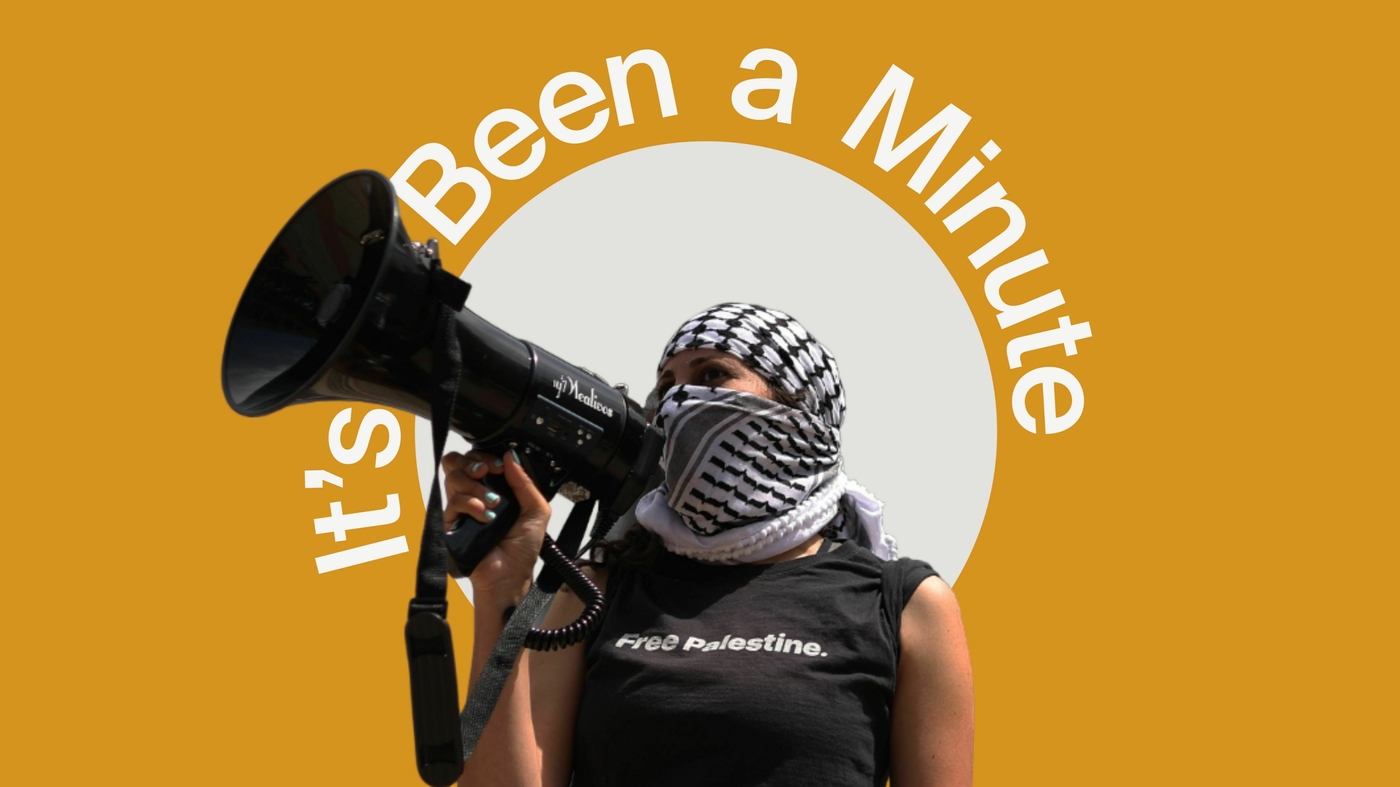
 Lifestyle1 day ago
Lifestyle1 day agoIs the free speech debate dead? Plus, the devil! : It's Been a Minute

